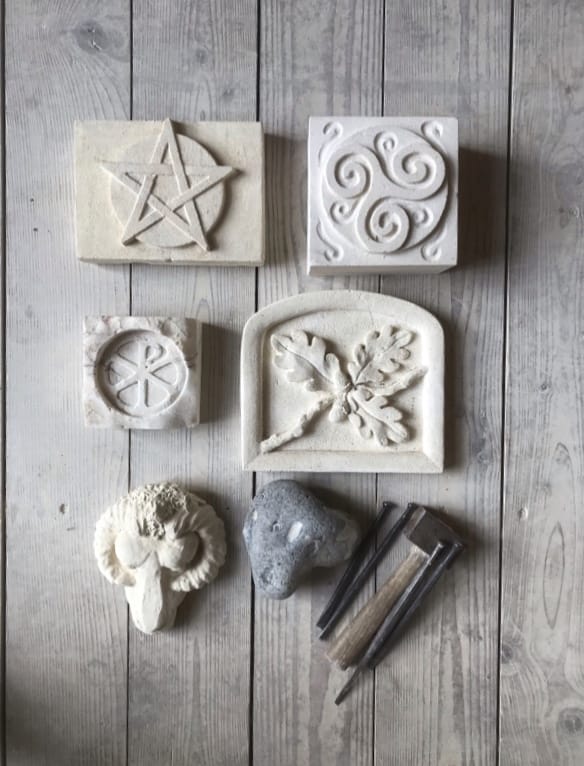Physical, Mental and Spiritual Well Being Through Craft
The Art of Well-Being: The Transformative Power of Stone Carving
In an age marked by digital overload and fast-paced lifestyles, the pursuit of well-being has become increasingly important. Among the myriad of activities that promote mental and emotional health, engaging in crafts stands out as a particularly enriching endeavour. Stone carving, a time-honoured art form, offers both a unique creative outlet and a powerful avenue for personal reflection, mindfulness, and healing.
The classical craft system predates yoga by 1,500 years, originating from practical needs. For 3,000 years, master craftspeople preserved many religious and societal mysteries. This education was lengthy and costly, emphasizing the importance of craftspeople’s mental and physical health for a prolonged, productive life. The metaphysics of craft posits that the universe consists of two realities: consciousness and nature, merging the practical with the metaphysical to cultivate strength, awareness, and harmony in mind and body.

The Connection Between Craft and Well-Being
Creative crafts have long been recognized as a pathway to well-being. Engaging in creative processes stimulates the brain, promotes relaxation, and allows for self-expression. The act of creating can distract us from stress and anxiety, providing a sense of accomplishment and focus.
Stone carving, with its unique demands and rewards, stands out for several reasons:
- Mindfulness and Presence: Carving stone requires intense concentration and attention to detail. As artisans chip away at the hard surface, they enter a state of flow—complete immersion in an activity. This state fosters mindfulness, grounding individuals in the present moment and providing a welcome respite from everyday stressors.
- Physical Engagement: The tactile nature of stone carving engages the body and mind in tandem. The physicality of chiseling and shaping stone not only builds strength and coordination but also releases endorphins, enhancing mood and reducing feelings of anxiety. This embodied experience is vital in a world where many people feel disconnected from their physical selves.
- Creative Expression: Stone carving is an artistic endeavor that allows individuals to express their emotions, ideas, and personal stories. Each piece becomes a unique representation of the artist’s journey, serving as a tangible manifestation of their thoughts and feelings. This creative outlet can provide a sense of purpose and identity, fostering resilience and emotional well-being.
- Connection to Nature: Working with stone creates a profound connection to nature, as each piece carries its own history and energy. Many carvers find inspiration in the natural forms, textures, and colors of the stone, which encourages a deep appreciation for the earth and its materials. This connection to nature has been shown to have numerous psychological benefits, promoting feelings of peace and reducing stress.
- Community and Collaboration: Stone carving can also foster a sense of community. Workshops and classes provide spaces for individuals to come together, share techniques, and inspire each other. The collaborative nature of this craft can strengthen social bonds, reduce feelings of isolation, and create a shared sense of purpose among participants.
The Training: A Timeless Path to Mastery and Well-Being
Unlike other craft courses, ours are taught by a Master trained and experienced in passing on the knowledge and skill of the craft of stonemasonry and stone carving in the traditional way.



My apprenticeship in stone carving was a direct link to the past—a traditional curriculum that echoes through the centuries. We were taught techniques that have remained unchanged for millennia, used by artisans who saw no separation between their work and the world around them. Back then, what we now call ‘spiritual practices’ were simply considered natural science, an essential part of the training. It was during this process that we also learned to care for our own physical, mental, and spiritual health. The curriculum was designed for those working with religious and spiritual communities of all denominations, and we were expected to create the very energy the work required.
The Bardic tradition involves the sharing and preservation of stories, songs, and poems, representing a vital aspect of our heritage. This tradition was traditionally utilized by the Guild to transmit essential skills, history, and culture through a sophisticated system of storytelling, poetry, and songs, creating a sense of community and continuity among its members. Today, we continue to uphold these traditions as a valuable complement to modern educational methods.
Storytelling serves as a potent tool for improving memory and learning by organizing information in a meaningful way, enhancing comprehension, retention, and application. Research indicates that storytelling has a profound impact on our brains, triggering the production of oxytocin, fostering empathy, and strengthening social connections. Furthermore, storytelling engages our imagination, activating multiple senses and enhancing memory retention. This emotional engagement with stories ensures that information is retained in the long term, making it a more effective educational tool than traditional revision methods.
Wellbeing Through Craft: Our Specialized Approach
While all our stone carving courses inherently offer significant physical, mental, and spiritual benefits, our dedicated ‘Wellbeing Through Craft’ range is wholly geared towards these aims. This isn’t a modern course in mindfulness; it’s the passing on of a quiet, powerful knowledge from a time when the sculptor, the stone, and the spirit were all one.
Beyond personal enjoyment, stone carving has found a place in therapeutic settings. Art therapy has been integrated into mental health practices, often utilising various forms of creative expression—including stone carving. Therapists may guide individuals in using this craft as a medium to explore and heal from trauma, express grief, or manage anxiety and depression. The act of transforming a raw stone into a sculpted piece can symbolize personal transformation and recovery, making it a powerful therapeutic tool.
Practice Mindfulness: As you carve, focus on the texture and shape of the stone. Allow yourself to immerse in the process, letting go of distractions and embracing the moment. Like any skill, the more you practice, the more proficient you will become. Regular engagement with carving will deepen its impact on your well-being.
Come and learn a skill forged in ancient wisdom.
